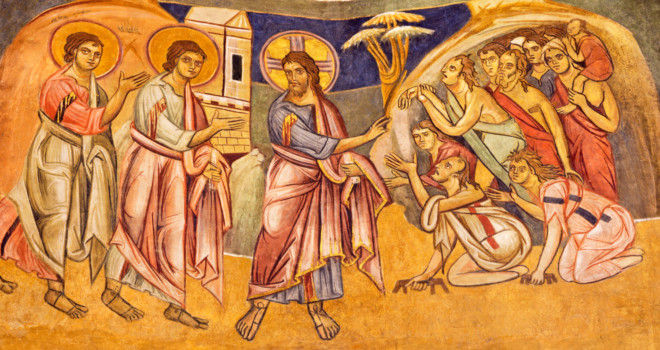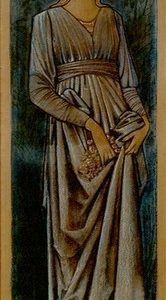By now, social distancing has been drilled into our
heads. As Catholics, called to love our neighbors this presents a particular
challenge, given that real tangible presence is the hallmark of incarnate
charity.
Fortunately, there are some biblical precedents to which we can look for guidance. Of particular relevance are Jesus’ healings of lepers given that leprosy was once believed to be highly contagious. For example, in the Middle Ages, lepers often lived in isolation or in colonies away from the rest of society. Those afflicted with the disease even had to wear bells to alert oncoming passersby of their presence (see this Encyclopedia Britannica article for more.)
Sound familiar?
Many of us are treating our fellow man on the street
as lepers today, and not without good reason. But as Catholics what should we
be doing?
In the gospels, there are two accounts of Jesus
healing lepers. One occurs in Luke 17:11-19:
As he continued his journey to Jerusalem, he traveled through Samaria and Galilee. As he was entering a village, ten lepers met him. They stood at a distance from him and raised their voice, saying, “Jesus, Master! Have pity on us!” And when he saw them, he said, “Go show yourselves to the priests.”As they were going they were cleansed.And one of them, realizing he had been healed, returned, glorifying God in a loud voice; and he fell at the feet of Jesus and thanked him. He was a Samaritan. Jesus said in reply, “Ten were cleansed, were they not? Where are the other nine? Has none but this foreigner returned to give thanks to God?” Then he said to him, “Stand up and go; your faith has saved you.”
The second healing occurs in all of the gospels
except John. Here is the version in Matthew 5:1-4:
When Jesus came down from the mountain, great crowds followed him. And then a leper approached, did him homage, and said, “Lord, if you wish, you can make me clean.” He stretched out his hand, touched him, and said, “I will do it. Be made clean.” His leprosy was cleansed immediately. Then Jesus said to him, “See that you tell no one, but go show yourself to the priest, and offer the gift that Moses prescribed;that will be proof for them.”
These stories hold a number of lessons for us.
Healing can occur without violating boundaries
What stands out about the first one is that Jesus
heals the ten lepers without coming into physical contact with them. It’s
striking because He certainly could have done so and because so many of His
healings were marked by physical contact.
Then again, Jesus often healed and worked other miracles simply by speaking. For example, in Matthew 8, the next story is about the healing of the centurion’s servant. Jesus offers to come to the servant but the centurion says Jesus’ verbal assurances are enough for him. Later, in verse 16, Matthew reports that Jesus “he drove out the spirits by a word.”
When we cannot experience the physical touch of
Jesus, we can still experience His words.
Healing through presence
We are not in a position to actually heal illnesses
the way that Jesus did—which is all the more reason for us to respect the social
distancing boundaries just as Jesus and the lepers did in their own way in Luke
17.
But there’s another kind of healing that Jesus did
that we also can do. That kind of healing focuses on the psychological
suffering brought about through illness. While Jesus did not close the distance
between Him and the lepers, He did recoil in disgust or fear—and this act alone
had significance, according to one early medieval commentator, Theophylact, who
is cited by St. Thomas Aquinas in his Catena Aurea:
They therefore stand afar off as if ashamed of the uncleanness which was imputed to them, thinking that Christ would loathe them as others did. Thus they stood afar off, but were made nigh unto Him by their prayers. For the Lord is nigh unto all them that call upon him in truth. (Ps. 145:18.) Therefore it follows, And they lifted up their voices, and said, Jesus, Master, have mercy upon us.
This is something we can all do. Moreover, it’s
something we can do without violating social distancing rules. We are often
told to stay six feet away from people in public and even six feet away from
people in our homes if we are self-quarantining (see this guide here,
for example).
The gospels don’t seem to ask us to endanger our
health or break the law. But they do seem to be asking us to overcome our fears
and be present to others: there’s still a lot that can happen at a distance of
six feet. This can be a profoundly isolating time for many people. As
Catholics, we are called to be healers who remedy this social ill. If we can’t
meet people in church halls or in bars, Catholic charity suggests that we
should go out of our way to meet people in other ways—on walks, in parks, on a
stroll through our neighborhood.
Christ can still touch us
But, then in the other healing account, Jesus does touch the leper. It should be evident that here is one area where the gospel does not tell us to literally follow his example. One early Church author, in commenting on this passage, said the Jesus law against contact with lepers with still in effect, in order to combat the spread of the disease. He says that Jesus not transgress this law because his touch brought a cure, rather than spread contaminants.
As for the rest of us, St. Chrysostom counsels us to instead follow the example of Elisha from the Old Testament, who healed Naaman without touching him (see 2 Kings 5). The story is striking for the ordinariness of the healing—Naaman is instructed to simply wash in the water of the Jordan and he is cured. The Old Testament writer goes out of his way to highlight how unremarkable the method of healing was:
Are not the rivers of Damascus, the Abana and the Pharpar, better than all the waters of Israel? Could I not wash in them and be cleansed?” With this, he turned about in anger and left. But his servants came up and reasoned with him: “My father, if the prophet told you to do something extraordinary, would you not do it? All the more since he told you, ‘Wash, and be clean’?” (verses 12 to 13).
Here then there seems to be three points for us
today. The first is to trust the ‘ordinary’ methods of medical science to bring
about healing for this disease—hopefully a vaccine, sooner rather than later. Second,
we should be attentive to the way God works through the ordinary. Jesus’ touch
of the leper, after all, was not an extraordinary act. He just touched Him.
Third, and finally, we should be reassured that, despite our illness or isolation, Jesus can still touch us, in ways either ordinary or extraordinary.
✠
image: The fresco Jesus healing the ten lepers in byzantine iconic style c. 1300 by Renata Sedmakova / Shutterstock.com












